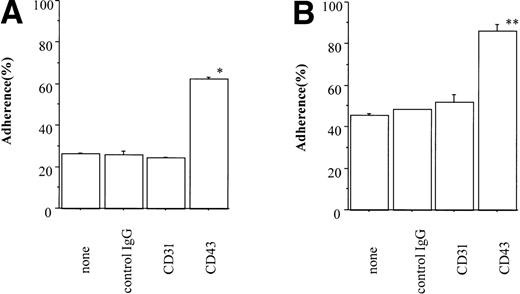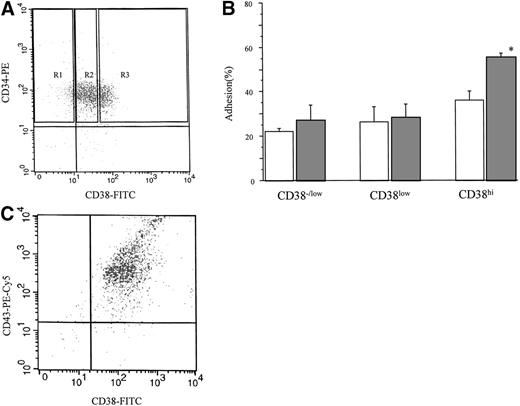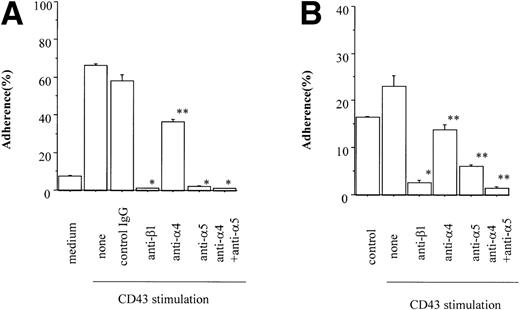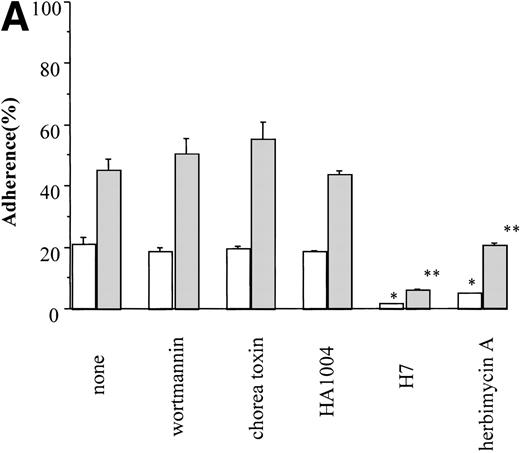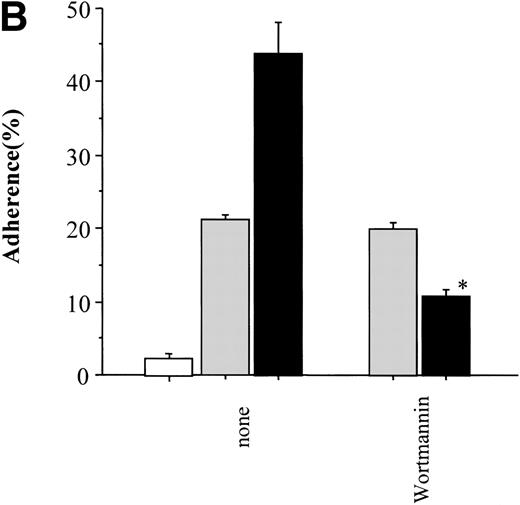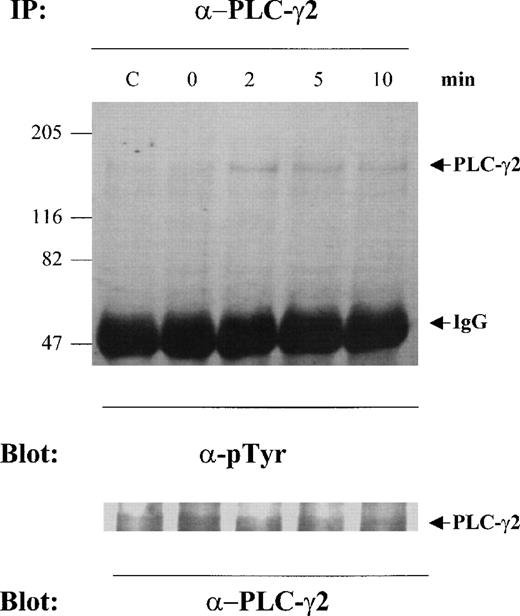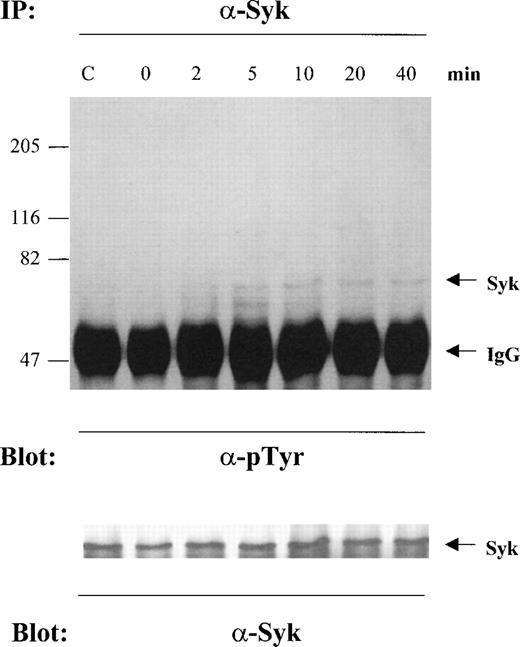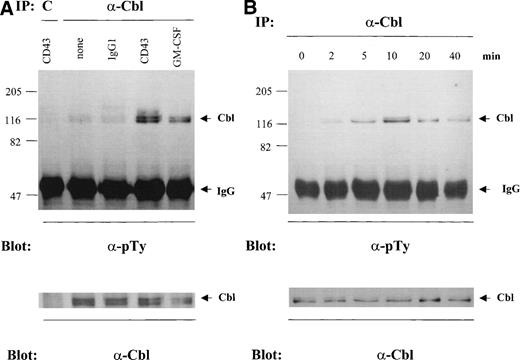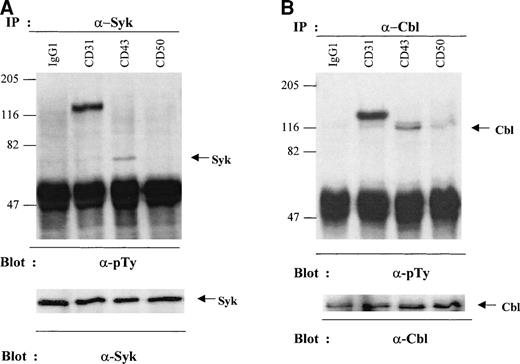Attachment of cells to extracellular matrix components is critical for the regulation of hematopoiesis. CD43 is a mucin-like transmembrane sialoglycoprotein expressed on the surface of almost all hematopoietic cells. A highly extended structure of extracellular mucin with negative charge may function as a repulsive barrier to hematopoietic cells. However, some investigators have shown that CD43 has proadhesive properties, and engagement of CD43 has been reported to upregulate integrin-mediated cell adhesion in T cells. We found that cross-linking of CD43 with monoclonal antibodies (MoAbs) enhanced integrin 4β1 (very late antigen [VLA]-4) and 5 β1 (VLA-5)-dependent adhesion of human cord blood CD34+ cells to fibronectin. CD34+ CD38hi, but not CD34+CD38−/low cells responded significantly to the stimulus, suggesting that committed, but not stem and more immature progenitors are sensitive to CD43-mediated activation of integrin. To elucidate the molecular mechanism leading to integrin activation, we used the growth factor-dependent cell line MO7e. Cross-linking of CD43 induced tyrosine phosphorylation of several intracellular molecules including the protein tyrosine kinase Syk, the proto-oncogene product Cbl, and phospholipase C (PLC)-γ2 in MO7e cells. Moreover, protein tyrosine kinase inhibitor herbimycin A and PLC inhibitor U73122 both blocked CD43-induced enhancement of adhesion to fibronectin. These results indicate that signals mediated through CD43 may increase integrin affinity to fibronectin via a pathway dependent on protein tyrosine kinase and PLC-γ activation in hematopoietic progenitors.
CD43 IS A MAJOR transmembrane sialoglycoprotein expressed on almost all hematopoietic cells except for erythrocytes and a population of B cells.1-3Pluripotent hematopoietic stem cells have been reported to express CD43 molecule.4 Multiple glycoforms are generated by modifications in the O-glycans attached to the protein core, giving rise to activation- or development-dependent isoforms.5-7Altered expression of CD43 has been reported in Wiskott-Aldrich syndrome8 and human immunodeficiency virus (HIV) infection.9
CD43 has a highly conserved cytoplasmic domain across species10 and cross-linking of CD43 with specific monoclonal antibodies (MoAbs) has various effects depending on cell types. These include activation of monocytes,11proliferation and activation of T cells,12-14 enhancement of natural killer (NK) cell activity,15 and induction of apoptosis in hematopoietic progenitors.16 An isoform-specific response has been also reported.7Intracellular signaling events reported are the generation of diacylglycerol and inositol phosphate, with calcium mobilization and protein kinase C (PKC) activation, and the activation of tyrosine kinase-dependent pathways in T cells.17-19
CD43 is a prototypic member of a family of cell surface-associated mucins, which are characterized by the presence of extensive O-linked glycan substitutions.20 A highly extended structure of extracellular mucin with negative charge may function as a repulsive barrier. The antiadhesive role of CD43, which prevents nonspecific binding, has been stressed in a number of studies.21-23 On the other hand, many mucins are long enough to gain optimal exposure of their terminal sugars, thus being accessible to interact with specific carbohydrate receptors. Some cell surface-associated mucins appear to be physiological ligands of selectins, and interaction of selectins with mucins initiate the adhesion cascade by which leukocytes move from the blood into tissue.20 In this context, a recent study suggested the significance of CD43-endotherial cell interaction in T-cell homing.24 Moreover, engagement of CD43 with specific MoAbs has been reported to enhance β1 and β2 integrin affinity in T cells.25
Integrins are heterodimeric transmembrane glycoproteins consisting of α and β subunits. The ligand-binding ability of integrin is regulated by cytoplasmic signals triggered on various external stimuli (inside-out signaling).26 Integrin-mediated adhesion is believed to be crucial in the homing and anchoring of hematopoietic cells to the bone marrow environment. In particular, the importance of very late antigen (VLA)-4 and VLA-5, which interact with fibronectin and vascular adhesion molecule-1, has been implicated in hematopoiesis.27 28 In this study, we show that cross-linking of CD43 with MoAbs enhances adhesion of human primary cord blood hematopoietic progenitors to immobilized fibronectin. Intracellular signaling events leading to integrin activation after engagement of CD43 were assessed using the human factor-dependent cell line, MO7e.
MATERIAL AND METHODS
Cytokine, antibodies, and reagents.
Recombinant human granulocyte-macrophage colony-stimulating factor (rhuGM-CSF) and steel factor were kindly provided by Immunex Corp (Seattle, WA). Anti-integrin β1 MoAb (clone Lia1/2), anti-integrin α4 MoAb (clone HP2/1), anti-integrin α5 MoAb (clone SAM1), anti-CD43 MoAb (clone DF-T1), anti-CD31 MoAb (clone 5.6E), anti-CD50 antibody (clone HP2/19), and F(ab’)2 fragment goat antimouse IgG were purchased from Immunotech (Westbrook, ME). Anti-Syk polyclonal Ab, raised against an epitope corresponding to amino acids 257-352 mapping within the linker region of Syk, anti-Zap-70 polyclonal Ab and anti-Cbl polyclonal Ab were from Santa Cruz Biotechnology (Santa Cruz, CA). Anti-CD43 (clone MEM-59), fluorescein isothiocyanate (FITC)-conjugated anti-CD38, phycoerythrin (PE)-conjugated anti-CD34 and PE-Cy5–conjugated F(ab’)2 fragment goat antimouse IgG were from Caltag Laboratories (Burlingame, CA). Antiphosphotyrosine (anti-pTyr) MoAb (4G10) and antiphospholipase C (PLC)-γ1 mixed MoAbs were from Upstate Biothechnology (Lake Placid, NY). Anti-PLC–γ2 polyclonal antibody was from Pharmingen (San Diego, CA). Wortmannin, H7, HA1004, herbimycin A, U73122, and U73343 were obtained from Calbiochem (San Diego, CA). Human fibronectin was purchased from Collaborative Biomedical (Bedford, MA).
Cell lines.
The human growth factor-dependent myeloid cell lines, MO7e and TF-1, were cultured in RPMI 1640 supplemented with 20% fetal bovine serum and 100 U/mL rhuGM-CSF. The biological characteristics of these cell lines have been described previously.29-31 Before cross-linking or cytokine stimulation, cells were washed twice, resuspended in RPMI 1640 supplemented with 1% bovine serum albumin (BSA), and then incubated for 18 hours at 37°C.
Cell sorting.
Mononuclear cells were isolated from cord blood by Ficoll-Hypaque (Pharmacia, Piscataway, NJ) gradient centrifugation. Next, mononuclear cells were preenriched for CD34+ cells using a Magnetic Cell Sorting (MACS) system (Miltenyi Biotec, Auburn, CA). Cells were then incubated with PE-conjugated anti-CD34 with or without FITC-conjugated anti-CD38 for 30 minutes at 4°C. Subsequently, CD34+ cells were sorted on a FACStar Plus (Becton Dickinson, Franklin Lakes, NJ). Sorted CD34+ cells were starved overnight in serum-free medium (QBSF58, Sigma, St Louis, MO) before adhesion assay.
Flow cytometory analysis.
Cord blood CD34+ cells isolated by MACS were first stained with anti-CD43 (DF-T1) followed by PE-Cy5–conjugated F(ab’)2 fragment goat antimouse IgG. After blocking the free binding sites of secondary antibody with mouse IgG, cells were stained with PE-conjugated anti-CD34 and FITC-conjugated anti-CD38. CD43 expression was analyzed on gated CD34+ cells by FACScan (Becton Dickinson). Cells stained with isotype-matched irrelevant MoAbs were used as a negative control.
Adhesion assay.
Human fibronectin was diluted in phosphate-buffered saline (PBS) at a concentration of 20 μg/mL and distributed in 96-well tissue culture flat-bottomed plates (Corning, Cambridge, NY). After overnight incubation at 4°C, the coated wells were washed twice with PBS and blocked by adding PBS with 1% BSA at 37°C for 1 hour. The wells were then washed twice with PBS. Cells were labeled with51Cr (Amersham, Arlington Heights, IL) (100 μCi/5 × 106 cells) at 37°C for 1 hour, washed twice, and resuspended in RPMI with 0.5% BSA. A total of 100 μL of the cell suspension was added to the protein-coated wells, centrifuged at 600 rpm for 1 minute, and incubated at 37°C for 20 minutes, except where otherwise indicated. Unattached cells were removed by two washes with prewarmed RPMI with 0.5% BSA. Adherent cells were solubilized with 1% sodium dodecyl sulfate (SDS), and then radioactivity was quantified by a scintillation counter. Percent adhesion was calculated as the ratio of the radioactivity in adherent cells to that of input, after correction of nonspecific binding to BSA-coated wells.
Engagement of CD43.
Cells were treated with 20 μg/mL anti-CD43 MoAb for 20 minutes at 4°C. Next, 10 μg/mL F(ab′)2 fragment goat antimouse IgG was added for 10 minutes at 4°C. Then, cells were incubated for indicated time periods at 37°C. Although anti-CD43 antibody alone had some effect on cell adhesion, we observed that secondary antibody enhanced the effect in preliminarily experiments using MO7e and cord blood CD34+ cells. Thus, we used secondary antibody in all experiments.
Immunoprecipitation and immunoblotting.
Cells were lysed in lysis buffer (20 mmol/L Tris-HCl [pH 7.4], 150 mmol/L NaCl, 10% glycerol, 1% Nonidet P-40, 1 mmol/L phenylmethyl sulfonyl fluoride [PMSF], 10 μg/mL aprotinin, 10 μg/mL leupeptin, 100 mmol/L NaF, and 1 mmol/L sodium orthovanadate) on ice for 20 minutes, and insoluble fractions were removed by centrifugation at 14,000g for 20 minutes. Equal amounts of protein were used for immunoprecipitation. Cell extracts were mixed with appropriate Ab at 4°C for 2 hours. Antigen-Ab complexes were collected with protein A-Sepharose beads (Pharmacia). Immunoprecipitates were washed with lysis buffer four times and separated by SDS-polyacrylamide gel electrophoresis (PAGE) and transferred to polyvinylidene difluoride (PVDF) membrane (Millipore, Bedford, MA). Membranes were blocked in Tris-buffered saline containing 0.5% Tween 20 and 1% BSA for 1 hour at room temperature and incubated with appropriate primary Abs for 2 hours. Blots were visualized using horseradish peroxidase-conjugated secondary Ab and an enhanced chemiluminescence system (ECL, Amersham). To reprobe with another first Ab, membranes were incubated in striping buffer (62.5 mmol/L Tris-HCl [pH 6.7], 100 mmol/L 2 mercaptoethanol [2ME], and 2% SDS) for 30 minutes at 50°C, washed, and then used for further study.
RESULTS
Engagement of CD43 enhances adhesion of hematopoietic progenitors to fibronectin.
We have used MO7e and TF-1 cells, CD34+ factor-dependent cell lines having primitive myeloid lineage characteristics, as a model system of integrin-mediated adhesion.32,33 MO7e and TF-1 cells have been reported to express a set of integrins similar to those of primary CD34+ cells.34 A line of studies suggests that integrin function in CD34+ hematopoietic progenitors can be activated by a number of cytokines.34-36Figure 1 shows that cross-linking of CD43 with MoAb DF-T1 also stimulates adhesion of MO7e and TF-1 cells to immobilized fibronectin. Similar effects were observed with another CD43 MoAb MEM-59 (data not shown). CD31 was expressed on MO7e and TF-1 cells (data not shown), however cross-linking of CD31 with MoAb 5.6E had no effect on attachment to fibronectin. Although MO7e cells are positive for a receptor for laminin (VLA-6), cross-linking of CD43 did not enhance attachment of MO7e cells to laminin (data not shown). The effect of CD43 engagement was prolonged (Fig 2) in comparison with those of cytokines, which induce transient cell attachment to fibronectin.32-34 Next, we investigated the effect of CD43 engagement on the adhesion of CD34+ cord blood progenitors to immobilized fibronectin. Because subpopulations of CD34+cells may display different sensitivity to the anti-CD43 MoAb treatment,16 we separated cord blood CD34+cells into three fractions on the basis of CD38 antigen expression (Fig 3A). Adhesion of CD34+CD38hi cells to fibronectin was enhanced in response to cross-linking of CD43. In contrast, cross-linking of CD43 did not have a significant effect on CD34+CD38−/low and CD34+CD38low cells (Fig 3B). We further examined the expression of CD43 in cord blood CD34+ cells. Most of the CD34+ cells were positive for CD43 and the expression of CD43 tended to correlate with that of CD38 (Fig3C).
CD43-mediated enhancement of (A) MO7e and (B) TF-1 cell adhesion to immobilized fibronectin. Radiolabeled cells were pretreated with medium (RPMI 1640 medium containing 1% BSA) alone, 20 μg/mL control IgG, anti-CD43 MoAb (clone DF-T1), or anti-CD31 MoAb (clone 5.6E) for 20 minutes at 4°C. Next, 10 μg/mL goat antimouse IgG was added for 10 minutes at 4°C. Cells were then distributed in flat-bottom 96-well plate coated with fibronectin. The plate was centrifuged at 600 rpm for 1 minute and incubated for 20 minutes at 37°C. Cell adhesion assay was performed as described in Materials and Methods. Data represent the mean ± standard error (SE) of triplicate assays for one of three reproducible experiments each. *P < .0001 versus control **P < .001 versus control.
CD43-mediated enhancement of (A) MO7e and (B) TF-1 cell adhesion to immobilized fibronectin. Radiolabeled cells were pretreated with medium (RPMI 1640 medium containing 1% BSA) alone, 20 μg/mL control IgG, anti-CD43 MoAb (clone DF-T1), or anti-CD31 MoAb (clone 5.6E) for 20 minutes at 4°C. Next, 10 μg/mL goat antimouse IgG was added for 10 minutes at 4°C. Cells were then distributed in flat-bottom 96-well plate coated with fibronectin. The plate was centrifuged at 600 rpm for 1 minute and incubated for 20 minutes at 37°C. Cell adhesion assay was performed as described in Materials and Methods. Data represent the mean ± standard error (SE) of triplicate assays for one of three reproducible experiments each. *P < .0001 versus control **P < .001 versus control.
Kinetics of MO7e cell adhesion to immobilized fibronectin. MO7e cells stimulated with or without anti-CD43 MoAb (clone DF-T1) and goat antimouse IgG were distributed in fibronectin-coated 96-well plate. The plate was incubated for the indicated time periods at 37°C and subjected to adhesion assay. Data represent the mean ± SE of triplicate assays for one of three reproducible experiments. *P < .01, **P < .001, ***P < .0001 versus control at each time point. (○), control; (◍), CD43-stimulated.
Kinetics of MO7e cell adhesion to immobilized fibronectin. MO7e cells stimulated with or without anti-CD43 MoAb (clone DF-T1) and goat antimouse IgG were distributed in fibronectin-coated 96-well plate. The plate was incubated for the indicated time periods at 37°C and subjected to adhesion assay. Data represent the mean ± SE of triplicate assays for one of three reproducible experiments. *P < .01, **P < .001, ***P < .0001 versus control at each time point. (○), control; (◍), CD43-stimulated.
Influence of CD43 on cord blood CD34+ cell subsets. (A) Gates used to select cord blood CD34+subpopulations based on CD38 expression. Cells were sorted by FACSstar Plus after MACS preenrichment. R1: CD34+CD38−/low cells; R2: CD34+CD38low cells; R3: CD34+CD38hi cells. (B) The effect of CD43 engagement on adhesion of CD34+ subpopulations to immobilized fibronectin. Cells were stimulated with isotype-matched control IgG or anti-CD43 MoAb (clone DF-T1) followed by goat antimouse IgG, then subjected to adhesion assay. Data represent the mean ± SE from three separate experiments with triplicate samples for each group in every experiment. *P < .05 versus control. (□), control; (▪) CD43-stimulated. (C) Expression of CD38 and CD43 on the CD34+ cell population. Three-color analysis was performed on the cells isolated from cord blood by MACS. Expression of CD38 and CD43 was analyzed on the gated CD34+ cell population by FACScan.
Influence of CD43 on cord blood CD34+ cell subsets. (A) Gates used to select cord blood CD34+subpopulations based on CD38 expression. Cells were sorted by FACSstar Plus after MACS preenrichment. R1: CD34+CD38−/low cells; R2: CD34+CD38low cells; R3: CD34+CD38hi cells. (B) The effect of CD43 engagement on adhesion of CD34+ subpopulations to immobilized fibronectin. Cells were stimulated with isotype-matched control IgG or anti-CD43 MoAb (clone DF-T1) followed by goat antimouse IgG, then subjected to adhesion assay. Data represent the mean ± SE from three separate experiments with triplicate samples for each group in every experiment. *P < .05 versus control. (□), control; (▪) CD43-stimulated. (C) Expression of CD38 and CD43 on the CD34+ cell population. Three-color analysis was performed on the cells isolated from cord blood by MACS. Expression of CD38 and CD43 was analyzed on the gated CD34+ cell population by FACScan.
CD43 enhanced-adhesion to fibronectin is integrin-dependent in MO7e and cord blood CD34+ cells.
To test if CD43 enhanced-adhesion to fibronectin was mediated by integrin, function-blocking anti-integrin antibodies were included in adhesion assay. Although anti-α4 MoAb (HP2/1) only partially blocked CD43 enhanced-adhesion to fibronectin in MO7e cells, the attachment was completely abrogated by anti-α5 MoAb (SAM1) or anti-β1 MoAb (Lia1/2) (Fig 4A). As for cord blood CD34+ cells, the enhancement of adhesion to fibronectin was partially inhibited by HP2/1 or SAM1. Complete inhibition was observed by the combined use of HP2/1 and SAM1 or by Lia1/2 (Fig 4B). These results indicate that CD43-enhanced adhesion is mediated through VLA-4 and VLA-5 in hematopoietic progenitors.
Effect of anti-integrin antibody on CD43-enhanced MO7e and cord blood CD34+ cell adhesion to fibronectin. (A) MO7e cells were treated with or without anti-CD43 MoAb (clone DF-T1) and goat antimouse IgG. CD43-stimulated cells were incubated with 10 μg/mL control IgG or anti-integrin antibody for an additional 20 minutes at 4°C and subjected to adhesion assay. Data represent the mean ± SE of triplicate assays for one of two reproducible experiments. *P < .0001, **P < .001 versus CD43-stimulated adhesion without additional antibodies. (B) Sorted CD34+ cells were treated with 20 μg/mL control IgG or CD43 (clone DF-T1) followed by goat antimouse IgG. CD43-stimulated cells were incubated with 10 μg/mL anti-integrin antibody for an additional 20 minutes at 4°C and subjected to adhesion assay. Data represent the mean ± SE from three separate experiments with triplicate samples for each group in every experiment. *P < .01, **P < .05 versus CD43-stimulated adhesion without additional antibodies.
Effect of anti-integrin antibody on CD43-enhanced MO7e and cord blood CD34+ cell adhesion to fibronectin. (A) MO7e cells were treated with or without anti-CD43 MoAb (clone DF-T1) and goat antimouse IgG. CD43-stimulated cells were incubated with 10 μg/mL control IgG or anti-integrin antibody for an additional 20 minutes at 4°C and subjected to adhesion assay. Data represent the mean ± SE of triplicate assays for one of two reproducible experiments. *P < .0001, **P < .001 versus CD43-stimulated adhesion without additional antibodies. (B) Sorted CD34+ cells were treated with 20 μg/mL control IgG or CD43 (clone DF-T1) followed by goat antimouse IgG. CD43-stimulated cells were incubated with 10 μg/mL anti-integrin antibody for an additional 20 minutes at 4°C and subjected to adhesion assay. Data represent the mean ± SE from three separate experiments with triplicate samples for each group in every experiment. *P < .01, **P < .05 versus CD43-stimulated adhesion without additional antibodies.
CD43 enhanced-adhesion is differentially inhibited by second messenger inhibitors in MO7e cells.
To clarify the pathway leading to integrin activation after engagement of CD43, we treated MO7e cells with second messenger inhibitors before adhesion assay (Fig 5A). Cholera toxin, an activator of adenyl cyclase, and wortmannin, a phosphatidylinositol 3 (PI3)-kinase inhibitor failed to suppress CD43 enhanced-adhesion to fibronectin. The same concentration of wortmannin greatly reduced enhancement of adhesion induced by steel factor (Fig 5B). Herbimycin A, a protein tyrosine kinase inhibitor, substantially suppressed adhesion augmented with CD43 cross-linking. H7, which inhibits both PKC and protein kinase A (PKA), but not HA1007, which inhibits PKA, but not PKC, almost completely blocked CD43-enhanced adhesion. Herbimycin A and H7 also suppressed background adhesion significantly. This may suggest the possibility that PKC and tyrosine kinase were necessary for constitutive adhesion to fibronectin in MO7e cells. Because PKC is considered to be one of the downstream signals of PLC and in some systems a PLC-PKC pathway is suggested to be involved in integrin inside-out signaling,36 37 we used the putative PLC inhibitor, U73122. This reagent suppressed CD43-enhanced adhesion in a dose-dependent manner (Fig 5C). U73343, a close analog to U73122, had no significant inhibitory effect on MO7e cell adhesion to fibronectin.
Effect of inhibitors on CD43-stimulated MO7e cell adhesion to fibronectin. (A) Cells were pretreated with 1 μmol/L wortmannin, 0.2 μg/mL chorea toxin, 50 μmol/L HA1004, or 50 μmol/L H7 for 30 minutes or 1 μg/mL herbimycin A for 18 hours at 37°C. Then, cells were cross-linked with anti-CD43 MoAb (clone DF-T1) and subjected to adhesion assay. *P < .01 versus control, **P < .01 versus CD43-stimulated adhesion without inhibitors. (□), control; (▩), CD43-stimulated; (B) Cells pretreated with 1 μmol/L wortmannin for 30 minutes at 37°C were cross-linked with anti-CD43 MoAb (clone DF-T1) or treated with 10 ng/mL steel factor and subjected to adhesion assay. *P < .01 versus steel factor-stimulated adhesion without wortmannin. (□), control; (▩), CD43-stimulated; (▪), steel factor-stimulated. (C) Cells were pretreated with U73122 at the indicated concentrations for 30 minutes at 37°C. Then, cells were cross-linked with anti-CD43 MoAb (clone DF-T1) and subjected to adhesion assay. *P < .05, **P< .001 versus CD43-stimulated adhesion without U73122. (○), control; (◍), CD43-stimulated; (•) pretreated with U733343 (2 μmol/L) before CD43 cross-linking; Data represent the mean ± SE of triplicate assays for one representative experiment of three reproducible experiments.
Effect of inhibitors on CD43-stimulated MO7e cell adhesion to fibronectin. (A) Cells were pretreated with 1 μmol/L wortmannin, 0.2 μg/mL chorea toxin, 50 μmol/L HA1004, or 50 μmol/L H7 for 30 minutes or 1 μg/mL herbimycin A for 18 hours at 37°C. Then, cells were cross-linked with anti-CD43 MoAb (clone DF-T1) and subjected to adhesion assay. *P < .01 versus control, **P < .01 versus CD43-stimulated adhesion without inhibitors. (□), control; (▩), CD43-stimulated; (B) Cells pretreated with 1 μmol/L wortmannin for 30 minutes at 37°C were cross-linked with anti-CD43 MoAb (clone DF-T1) or treated with 10 ng/mL steel factor and subjected to adhesion assay. *P < .01 versus steel factor-stimulated adhesion without wortmannin. (□), control; (▩), CD43-stimulated; (▪), steel factor-stimulated. (C) Cells were pretreated with U73122 at the indicated concentrations for 30 minutes at 37°C. Then, cells were cross-linked with anti-CD43 MoAb (clone DF-T1) and subjected to adhesion assay. *P < .05, **P< .001 versus CD43-stimulated adhesion without U73122. (○), control; (◍), CD43-stimulated; (•) pretreated with U733343 (2 μmol/L) before CD43 cross-linking; Data represent the mean ± SE of triplicate assays for one representative experiment of three reproducible experiments.
Engagement of CD43 induced tyrosine phosphorylation of PLC-γ2 p72Syk and p120Cbl in MO7e cells.
Signals via CD43 in T cells are suggested to be mediated through protein tyrosine kinases, PLC and PKC.17-19 The result of second messenger inhibitors suggested involvement of these pathways in CD43-mediated integrin inside-out signaling in MO7e cells. PLC-γ isozymes are known to be activated through phosphorylation. We investigated whether PLC-γ became phosphorylated on cross-linking of CD43. PLC-γ1 was only marginally affected (data not shown), but PLC-γ2 was significantly tyrosine phosphorylated by CD43 engagement (Fig 6). The implication of Syk family tyrosine kinase in the phosphorylation of PLC-γ has been suggested.38,39 We found that engagement of CD43 induced tyrosine phosphorylation of Syk protein tyrosine kinase (Fig 7). Tyrosine phosphorylation of ZAP-70, a family member of Syk, was not detectable (data not shown). The proto-oncogene product, c-Cbl, may play a critical role in signal transduction pathways mediated by cytokines in hematopoietic cells40,41 and an interaction with Syk has been reported.42 These observations led us to examine the possibility of involvement of c-Cbl in CD43-mediated signaling. c-Cbl was tyrosine phosphorylated in a time-dependent manner and the peak phosphorylation was observed 10 minutes after CD43 engagement. The degree of tyrosine phosphorylation of c-Cbl was almost equal to that observed after stimulation with 100 U/mL GM-CSF (Fig 8). We could not detect association of Syk or PLC-γ with Cbl by a combination of immunoprecipitation and immunoblotting (data not shown). We further examined whether engagement of other adhesion molecules expressed on MO7e cells could modify tyrosine phosphorylation of these proteins. Cross-linking of CD31 or CD50 induced no significant tyrosine phosphorylation of Syk and Cbl in MO7e cells (Fig 9). Similar results were observed in the case of PLC-γ2 (data not shown). These results suggest that the tyrosine phosphorylation events we observed were specific to CD43-mediated signaling and a potential involvement of Fc receptor was unlikely.
Tyrosine phosphorylation of PLC-γ2 by engagement of CD43. MO7e cells cross-linked with anti-CD43 MoAb (clone DF-T1) were incubated for the indicated time periods at 37°C. Cells treated with isotype-matched control IgG and goat antimouse IgG were incubated for 10 minutes at 37°C (Lane C). Cell lysates were immunoprecipitated with anti-PLC–γ2 Ab. Upper panel: these immunoprecipitates were separated by 7.5% SDS-PAGE and immunoblotted with antiphosphotyrosin MoAb; lower panel: the same membrane was reprobed with anti-PLC–γ2 Ab. These are the representative results from three separate experiments.
Tyrosine phosphorylation of PLC-γ2 by engagement of CD43. MO7e cells cross-linked with anti-CD43 MoAb (clone DF-T1) were incubated for the indicated time periods at 37°C. Cells treated with isotype-matched control IgG and goat antimouse IgG were incubated for 10 minutes at 37°C (Lane C). Cell lysates were immunoprecipitated with anti-PLC–γ2 Ab. Upper panel: these immunoprecipitates were separated by 7.5% SDS-PAGE and immunoblotted with antiphosphotyrosin MoAb; lower panel: the same membrane was reprobed with anti-PLC–γ2 Ab. These are the representative results from three separate experiments.
Tyrosine phosphorylation of p72Syk by engagement of CD43. MO7e cells cross-linked with anti-CD43 MoAb (clone DF-T1) were incubated for the indicated time periods at 37°C. Cells treated with isotype-matched control IgG and goat antimouse IgG were incubated for 10 minutes at 37°C (Lane C). Cell lysates were immunoprecipitated with anti-Syk Ab. Upper panel: these immunoprecipitates were separated by 7.5% SDS-PAGE and immunoblotted with antiphosphotyrosine MoAb; lower panel: the same membrane was reprobed with anti-Syk. These are the representative results from three separate experiments.
Tyrosine phosphorylation of p72Syk by engagement of CD43. MO7e cells cross-linked with anti-CD43 MoAb (clone DF-T1) were incubated for the indicated time periods at 37°C. Cells treated with isotype-matched control IgG and goat antimouse IgG were incubated for 10 minutes at 37°C (Lane C). Cell lysates were immunoprecipitated with anti-Syk Ab. Upper panel: these immunoprecipitates were separated by 7.5% SDS-PAGE and immunoblotted with antiphosphotyrosine MoAb; lower panel: the same membrane was reprobed with anti-Syk. These are the representative results from three separate experiments.
Tyrosine phosphorylation of p120Cbl by engagement of CD43. (A) MO7e cells treated with isotype-matched control IgG or anti-CD43 MoAb (clone DF-T1) followed by goat antimouse IgG or 100 U/mL GM-CSF were incubated for 10 minutes at 37°C. Cell lysates were immunoprecipitated with anti-Cbl Ab or preimmune rabbit serum (lane C). Upper panel: these immunoprecipitates were separated by 7.5% SDS-PAGE and immunoblotted with antiphosphotyrosine MoAb; lower panel: the same membrane was reprobed with anti-Cbl. (B) MO7e cells cross-linked with anti-CD43 MoAb (clone DF-T1) were incubated for the indicated time periods at 37°C. Cell lysates were immunoprecipitated with anti-Cbl Ab and followed by immunoblotting with antiphosphotyrosine MoAb (upper panel) and reprobing with anti-Cbl Ab (lower panel). These are the representative results from three separate experiments.
Tyrosine phosphorylation of p120Cbl by engagement of CD43. (A) MO7e cells treated with isotype-matched control IgG or anti-CD43 MoAb (clone DF-T1) followed by goat antimouse IgG or 100 U/mL GM-CSF were incubated for 10 minutes at 37°C. Cell lysates were immunoprecipitated with anti-Cbl Ab or preimmune rabbit serum (lane C). Upper panel: these immunoprecipitates were separated by 7.5% SDS-PAGE and immunoblotted with antiphosphotyrosine MoAb; lower panel: the same membrane was reprobed with anti-Cbl. (B) MO7e cells cross-linked with anti-CD43 MoAb (clone DF-T1) were incubated for the indicated time periods at 37°C. Cell lysates were immunoprecipitated with anti-Cbl Ab and followed by immunoblotting with antiphosphotyrosine MoAb (upper panel) and reprobing with anti-Cbl Ab (lower panel). These are the representative results from three separate experiments.
Effect of engagement of cell surface molecules on tyrosine phosphorylation of p72Syk and p120Cbl. MO7e cells were cross-linked with the indicated antibodies for 10 minutes at 37°C. (A) Cell lysates were immunoprecipitated with anti-Syk Ab and followed by immunoblotting with antiphosphotyrosine MoAb (upper panel) and reprobing with anti-Syk Ab (lower panel). (B) Cell lysates were immunoprecipitated with anti-Cbl Ab and followed by immunoblotting with antiphosphotyrosin MoAb (upper panel) and reprobing with anti-Cbl Ab (lower panel). The tyrosine-phosphorylated band around 130 kD in the lanes from cell lysates stimulated with anti-CD31 MoAb is supposed to be CD31 molecule bound to protein A through the antibody used for cross-linking. These are the representative results from two separate experiments.
Effect of engagement of cell surface molecules on tyrosine phosphorylation of p72Syk and p120Cbl. MO7e cells were cross-linked with the indicated antibodies for 10 minutes at 37°C. (A) Cell lysates were immunoprecipitated with anti-Syk Ab and followed by immunoblotting with antiphosphotyrosine MoAb (upper panel) and reprobing with anti-Syk Ab (lower panel). (B) Cell lysates were immunoprecipitated with anti-Cbl Ab and followed by immunoblotting with antiphosphotyrosin MoAb (upper panel) and reprobing with anti-Cbl Ab (lower panel). The tyrosine-phosphorylated band around 130 kD in the lanes from cell lysates stimulated with anti-CD31 MoAb is supposed to be CD31 molecule bound to protein A through the antibody used for cross-linking. These are the representative results from two separate experiments.
DISCUSSION
Integrin affinity of CD34+ hematopoietic progenitors is reported to be modulated by a number of cytokines34-36 or engagement of adhesion molecules such as CD31.43 Here, we presented data showing that the cell surface mucin CD43 could mediate signals, which upregulate integrin functional activity in hematopoietic progenitors.
Evidence for CD43 as a barrier molecule, which negatively regulates cell-cell and cell-ligand interaction, has been presented. Transfection of CD43 into HeLa cell interfered with interaction of T cells to these cells21 and targeted disruption of CD43 gene enhanced T-cell adhesiveness.22 Cross-linking of CD43 may provide a mechanism such as capping of surface mucin to one side of cells and unmasking integrins.44 However, failure of enhancement of adhesion to laminin made such an unspecific mechanism unlikely. In this regard, our results are similar to upregulation of integrin affinity by CD43 engagement in T cells.25
Recent studies have shown the importance of PI3-kinase in integrin inside-out signaling.45-47 Adhesion induced by hematopoietic growth factors was sensitive to the PI3-kinase inhibitor wortmannin.31,48 However, wortmannin failed to modulate CD43-mediated attachment to fibronectin, suggesting a negligible role for PI3-kinase in this system. Platelet-derived growth factor (PDGF) receptor expressed in mast cells could initiate two independent pathways leading to integrin activation, one dependent on PI3-kinase and the other dependent on PLC-γ and PKC.37The tyrosine phosphorylation of PLC-γ after engagement of CD43 and the blocking effect of the PKC inhibitor, H7, suggest the possibility that the PLC-γ and PKC-dependent pathway might be also activated in this system. In further support of the role of PLC in integrin inside-out signaling, the putative PLC inhibitor, U73122, which has been reported to inhibit integrin-mediated polymorphonuclear neutrophil (PMN) adhesion,49 blocked CD43-enhanced adhesion of MO7e cells to fibronectin. Considering the difference in sensitivity to inhibitors and kinetics of adhesion, CD43 may elicit signals leading to integrin activation that are distinct from those mediated by hematopoietic growth factors.
CD43 is reported to be associated with Fyn and Lck tyrosine kinases19,50 and may modulate tyrosine phosphorylation of specific cellular proteins in T cells.51 Recently, tyrosine phosphorylation of the proto-oncogene product Vav and activaton of mitogen-activated protein kinase have been recognized as downstream signals.52 Our results suggest that signaling via CD43 could affect the tyrosine phosphorylation status of some cellular proteins also in primitive myeloid cells. We identified some of these proteins as PLC-γ2, the protein tyrosine kinase p72syk, and the proto-oncogene product p120cbl. The fact that the protein tyrosine kinase inhibitor, herbimycin A, reduced CD43-enhanced MO7e cell adhesion to fibronectin may indicate the possible participation of some of these proteins in integrin inside-out signaling.
The role of Syk kinase family in primitive myeloid cells is largely unknown. We recently reported that integrin cross-linking, but not cytokines, induced Syk tyrosine phosphorylation.33 This study presents another possible pathway leading to Syk activation, although the involvement of Syk in PLC-γ phosphorylation or integrin inside-out signaling is uncertain at present.
The proto-oncogene product, c-Cbl, is inducibly phosphorylated after engagement of many types of receptors. c-Cbl contains a proline-rich domain and several potential tyrosine phosphorylation sites, which can function as ligands for SH2 and SH3 domains of multiple signaling proteins. c-Cbl is suggested to function as a complex adapter molecule modulating signaling pathways such as RAS, JAK/STAT, and PI3-kinase.53-55 In mast cells, overexpression of c-Cbl resulted in inhibition of kinase activity of Syk, suggesting that c-Cbl may have a direct effect on enzyme activity with which it associates.42 Our study suggests that c-Cbl also has a potential role in CD43-mediated signaling. Although the mechanism of c-Cbl involvement remains to be elucidated, we suspect c-Cbl may be an important signal transducer because of its major phosphorylation compatible with that induced by GM-CSF.
CD43 has been reported to mediate signals leading to apoptosis in cytokine-activated dividing population of CD34+ bone marrow cells, but not in quiescent stem cells.16 The CD34+CD38− immunophenotype defined a quiescent subpopulation in both cord blood and bone marrow and the percentage of CD34+ cells in cycle directly correlated with increasing CD38 expression.56 Our results showed that the CD34+CD38hi subpopulation responded most to integrin activation through CD43. Thus, it is highly possible that at least a part of CD34+ cells are susceptible to both apoptosis and integrin inside-out signals. CD43-mediated apoptosis might be induced in an isoform-specific manner.7 However, the following observations suggest that apoptosis and integrin inside-out signals may be mediated through the same isoform of CD43. MEM-59, which has been reported to induce apoptosis in CD34+ bone marrow cells, also enhanced attachment to fibronectin in MO7e cells. DF-T1 and MEM-59 has been reported to bind the same or closely related sialic acid-dependent epitope,57 and both MoAbs recognized the identical molecular weight protein in Western blotting of MO7e and TF-1 cell lysate (data not shown). Taking the correlation of CD38 and CD43 expression in CD34+ cells into account, CD43hicell might react to cross-linking of CD43. CD34+ cells in a certain stage of commitment may be effected preferentially by signaling mediated through CD43. The execution of apoptosis by CD43 required immobilized anti-CD43 MoAb and the presence of cytokine.16Compared with integrin inside-out signaling, more profound engagement of CD43 and other stimuli may be necessary for apoptosis.
Supposing an unidentified ligand for CD43 is expressed on the bone marrow stromal cells, CD43 may mediate signaling regulating cell adhesion or survival in the bone marrow microenvironment. Our results suggest that signaling via CD43 may be distinct from cytokine signaling and further studies on the cooperative effect of cytokine receptors and CD43 could provide novel insight into understanding mechanisms regulating the development of hematopoietic progenitors in the microenvironment.
ACKNOWLEDGMENT
We thank Charlie Mantel for helpful discussion.
Supported by U.S. Public Health Service Grants No. R01 DK53674, R01 HL56416, R01 HL54037, and a project in P01 HL53586 from the National Institutes of Health (NIH) (to H.E.B.).
The publication costs of this article were defrayed in part by page charge payment. This article must therefore be hereby marked “advertisement” in accordance with 18 U.S.C. section 1734 solely to indicate this fact.
REFERENCES
Author notes
Address reprint requests to Hal E. Broxmeyer, PhD, Walther Oncology Center, Indiana University School of Medicine, 1044 W. Walnut St, Rm 302, Indianapolis, IN 46202; e-mail:hbroxmey@iupui.edu.

